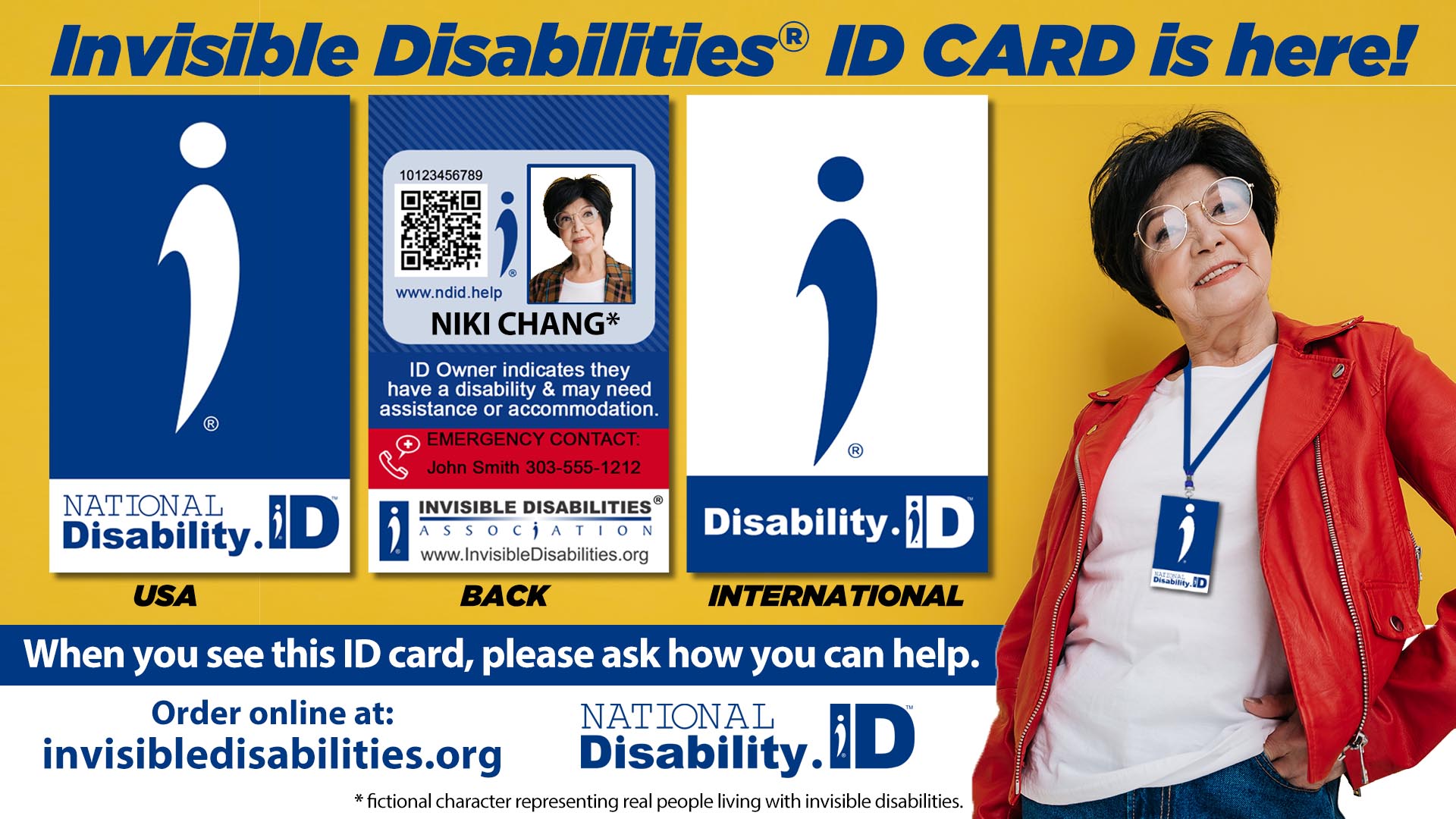Voluntary Disability ID Card Provides Help

Parker, CO, May 12, 2020 --(PR.com)-- A new Disability ID Card is being offered by the Invisible Disabilities® Association (IDA) as part of their National Disability ID initiative, a grassroots effort that raises awareness and provides help for people living with invisible disabilities. The Disability ID Card, which is professionally designed, durable plastic and personalized, can be carried in a pocket, wallet, purse or displayed with the use of a neck lanyard during situations where a person may need extra help such as riding public transportation, shopping or traveling.
The National Disability ID (NDID) initiative launched by IDA began in 2017 as a legislative initiative that allows the option for a designated symbol on government ID’s for voluntary disclosure of any disability. Alaska was the first state to pass the legislation and IDA is currently working with legislative sponsors in multiple other states.
One of the most difficult situations of living with invisible disabilities is being believed that the disabilities are real. “I have a valid disability placard for my car, but I have regularly been harassed if I park in an accessible space and someone sees me walking to or from my car,” says Sherri Connell, wife of IDA founder Wayne Connell. Sherri lives with Lyme Disease, MS, PTSD and other invisible disabilities that make it very difficult for her to care for her own daily needs. “Many of my friends and followers of IDA have been asking for this type of ID for a long time based on their own negative experiences and stories of discrimination because of disbelief.”
“We are meeting a critical need for people who live with disabilities on a daily basis and may need an accommodation or assistance away from their homes,” says Jess Stainbrook, Executive Director of the Invisible Disabilities® Association. An invisible disability refers to symptoms such as debilitating pain, fatigue, dizziness, cognitive dysfunctions, brain injuries, learning differences and mental health disorders, as well as hearing and vision impairments. “People living with disabilities represent the largest minority group in the world, as well as the only group that any of us can become a part of at any time,” adds Stainbrook.
The term “invisible disabilities” defines disabilities that are hidden or not readily seen because, in most situations, there is no visible assistive device like a wheelchair, mobility cane or walker. IDA is creating special certification training courses that will help law enforcement, first responders, educators, retailers and business owners understand how to interact in a positive way and provide assistance for people displaying the Disability ID Card.
For more information on the National Disability ID, go to InvisibleDisabilities.org
The National Disability ID (NDID) initiative launched by IDA began in 2017 as a legislative initiative that allows the option for a designated symbol on government ID’s for voluntary disclosure of any disability. Alaska was the first state to pass the legislation and IDA is currently working with legislative sponsors in multiple other states.
One of the most difficult situations of living with invisible disabilities is being believed that the disabilities are real. “I have a valid disability placard for my car, but I have regularly been harassed if I park in an accessible space and someone sees me walking to or from my car,” says Sherri Connell, wife of IDA founder Wayne Connell. Sherri lives with Lyme Disease, MS, PTSD and other invisible disabilities that make it very difficult for her to care for her own daily needs. “Many of my friends and followers of IDA have been asking for this type of ID for a long time based on their own negative experiences and stories of discrimination because of disbelief.”
“We are meeting a critical need for people who live with disabilities on a daily basis and may need an accommodation or assistance away from their homes,” says Jess Stainbrook, Executive Director of the Invisible Disabilities® Association. An invisible disability refers to symptoms such as debilitating pain, fatigue, dizziness, cognitive dysfunctions, brain injuries, learning differences and mental health disorders, as well as hearing and vision impairments. “People living with disabilities represent the largest minority group in the world, as well as the only group that any of us can become a part of at any time,” adds Stainbrook.
The term “invisible disabilities” defines disabilities that are hidden or not readily seen because, in most situations, there is no visible assistive device like a wheelchair, mobility cane or walker. IDA is creating special certification training courses that will help law enforcement, first responders, educators, retailers and business owners understand how to interact in a positive way and provide assistance for people displaying the Disability ID Card.
For more information on the National Disability ID, go to InvisibleDisabilities.org
Contact
Invisible Disabilities Association
Jess Stainbrook
720-605-9605
https://InvisibleDisabilities.org
Jess Stainbrook
720-605-9605
https://InvisibleDisabilities.org
Multimedia

New Disability ID Card from Invisible Disabilities Association
PDF version of press release
Categories
